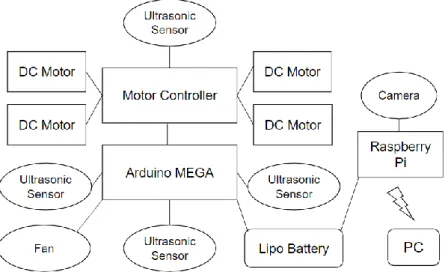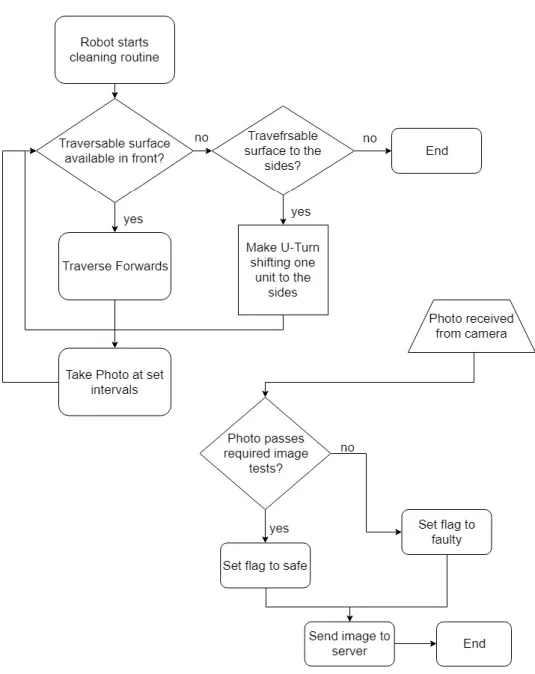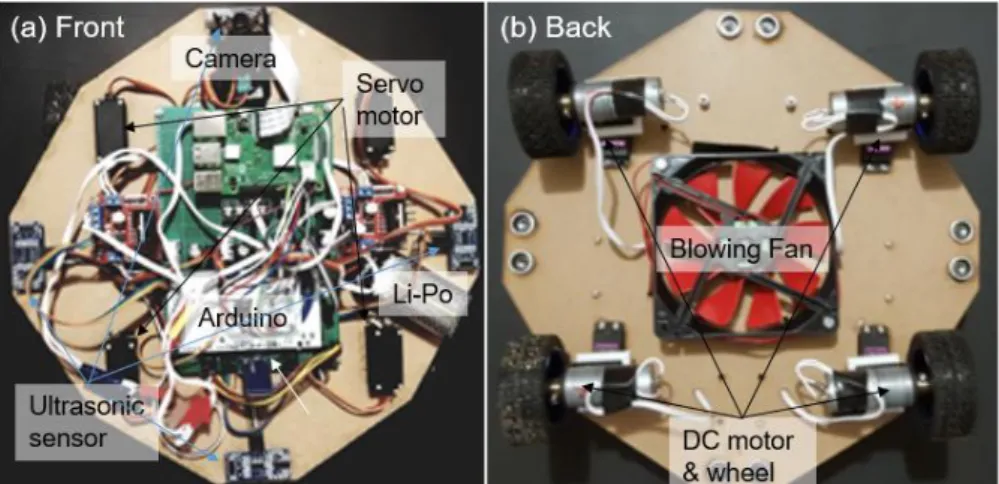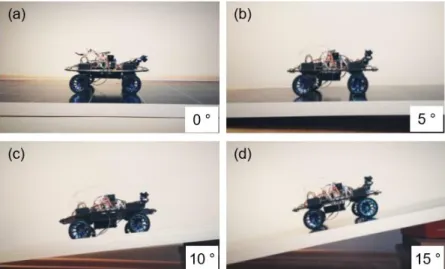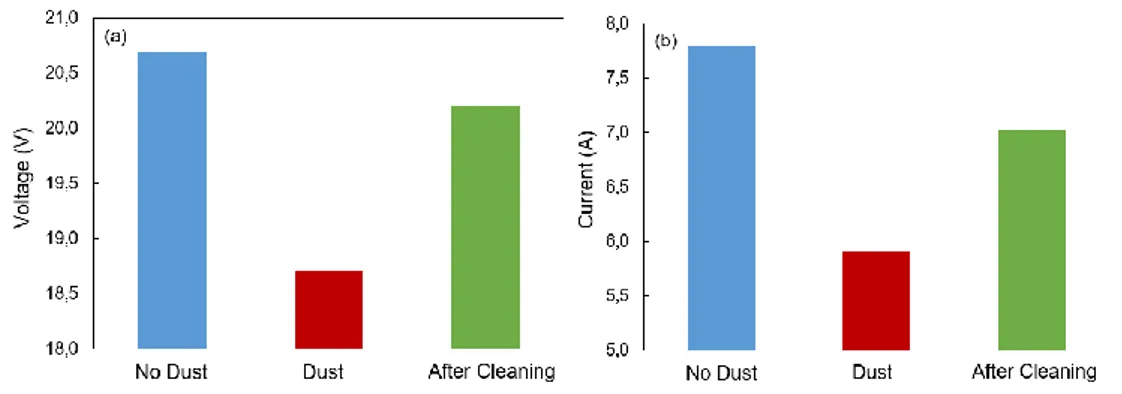UTILIZATION OF ROBOTICS FOR SOLAR PANEL CLEANING AND MAINTENANCE
1Haon PARK, 2Abdullah ÖZTÜRK, 3Hajun PARK, 4Muhammed Umer KHAN
1,3OASIS International School, 06830 Ankara, TURKEY
2,*Middle East Technical University, Faculty of Engineering, Department of Metallurgical and Materials Engineering, 06800 Ankara, TURKEY
4ATILIM University, Falculty of Engineering, Department of Mechatronics Engineering, 06836Ankara, TURKEY 1oasishaon@gmail.com, 2abdullah@metu.edu.tr, 3ankarahajun@gmail.com, 4umer.khan@atilim.edu.tr
(Geliş/Received: 15.03.2019; Kabul/Accepted in Revised Form: 28.04.2019)
ABSTRACT: In this study, a portable and low-cost solar panel cleaning robot with a functioning to blow away dust was designed and built to incur labor costs.The robot is service effective, environmentally friendly, energy independent, self-automated, long durable, and cost-effective. After cleaning operation, output voltage and current in solar panel increased by 8.02% and 18.78%, respectively. Moreover, the image processing with the photos taken by a camera fixed on the robot made classification according to color changes in the solar panel. Therefore, it can be concluded that the automated and multifunctional robot may facilitate the solar panel surface cleaning and be an applicable maintenance method through remote monitoring of the surface conditions.
Key Words: Solar panel, Robotics, Dust mitigation, Autonomous cleaning system, Image processing.
Güneş Paneli Temizliği ve Bakımı için Robotik Sistemin Uygulanması
ÖZ: Bu çalışmada, taşınabilir, düşük maliyetli ve toz üfleme işlevine sahip bir güneş paneli temizleme robotu tasarlanmış ve üretilmiştir. Robot servis etkin, çevre dostu, enerji bağımsız, kendinden otomatik, uzun ömürlü ve uygun maliyetlidir. Temizleme işleminden sonra, güneş panelinin çıkış voltajında ve akımında sırasıyla %8,02 ve %18,78 artış görülmüştür. Ayrıca, robot üzerindeki kamera ile çekilen fotoğraflara uygulanan görüntü işleme, güneş panellerindeki renk değişimlerine göre sınıflandırma yapmıştır. Dolayısıyla, çok fonksiyonlu otomasyon robotun güneş panellerinin yüzey temizlenmesini kolaylaştıracağı ve yüzey koşullarının uzaktan izlenmesi suretiyle bakımına olanak sağlayan uygulanabilir bir yöntem olacağı sonucuna varılabilir.
Anahtar Kelimeler: Güneş paneli, Robot, Toz azaltma, Özgün temizleme sistemi, Görüntü işleme.
INTRODUCTION
Renewable energy technologies are the center of current concerns regarding energy security, the environment, and global climate change in developed and developing nations. Among these clean-energy approaches, solar clean-energy technologies continue to grow in residential, commercial, agricultural, and industrial applications. The solar energy, which comes from the sun in the form of solar irradiance, can be directly converted to electricity by the use of photovoltaic (PV) solar panel. The PV panels, in general, are made of semiconductors to absorb the irradiance from the sun and convert it into electrical energy. Currently, dominant silicon-based PV panels have 26-27% energy conversion efficiencies which are very close to the theoretical limit (McGehee, 2013; Nakazakiet.al., 2018). Thus, in order to increase the
efficiency of the PV system, some improvements should be considered in the maintenance of PV panels. In this regard, keeping the surface of PV solar panel clean for enough solar irradiance absorption is among the encouraging strategies.
The PV based solar power systems possess many advantages including long-lasting, minimum operational control requirement, small maintenance free, and maximum electricity yielding during peak load demand periods like summer or noon (Charfiet.al., 2018; Nandal et.al., 2018; Waqas et.al., 2018). These advantages make them attractive for small and large scale investments. Despite all these benefits, dust accumulation can restrict the expected performance of the solar cells in hot and arid areas (Kaldelliset.al., 2011). Dust is one of the significant challenges for the PV solar panels as large scale solar power plants are established in remote desert areas where dust can be produced and deposited on the solar panels easily. The dust considerably reduced the maximum current from 6.9% to 16.4% depending on the time period of PV panels' exposure in dust affected environment of Iraq (Saidan et. al., 2016). Kalogirou et.al., (2013) have conducted the outdoor test in Cyprus with three different types of PV panels to examine the effect of soiling on their performance. After 10 weeks of exposure to the natural environment without any cleaning, the power output reduction was changed between 8 and 15% depending on the types of PV panels. It has been reported that solar irradiation was reduced 9% with dirt/dust deposition, but within one month because of rain which washed the surface, it reduced to 5% of loss (Al-Helal and Alhamdan, 2009). Ghazi et.al.(2014) carried out a comprehensive review of the dust deposition and settlement effect on the PV panels. They demonstrated the dust phenomenon and showed that the dust accumulation on the surface of solar panels is different in many countries. They also suggested that the appropriate cleaning method suited for the specific location should be chosen.
Several different cleaning methods have been utilized to remove the dust on solar panels (He et.al., 2011; Maghami et.al., 2016). The first and perhaps the most common method is washing the surfaces of solar panels with water. However, for some countries in the Middle East where the cost of water is much expensive than that of petrol, using water will not be practical. The second method is the usage of an air compressor to blow away dust, resulting in dust particles to be suspended in the air and cumulating again within a certain period of time. The third method is to use a manual system whereby the panel is tilted to let the dust fall. It is energy and labor intensive, so it is not feasible. The fourth method is to utilize a self-cleaning film on the solar panel (Gholami et.al.,2017). The coated hydrophobic or hydrophilic nanofilms change the wetting properties of the surface and dust will be removed away easily with rainwater. However, it should be accepted transmission coefficient loss caused by the coated layer. The last method is to incorporate robotic cleaning system to remove dust accumulation. Alshehri et.al. (2014) developed an installed robotic cleaning solution and represented the most promising technology investigated. Although it may be efficient, these fixed robotic systems are expensive and difficult to install over a large PV area.
Considering all these pros and cons, an autonomous cleaning system could be a solution for dust mitigation in PV panels. In this research, a prototype of a portable automated cleaning robot is proposed. This robot utilizes a dry system of blowing to clean the dust on the solar panel, and no water is needed during operation. Moreover, it is able to inspect whether there are any defects or cracks on the surface of the solar panel. The proposed solution is service effective, environmentally friendly, energy independent, self-automated, long durable, and cost-effective. This research is aimed to examine how reliable the motions of the robot will be when travelling on sloped surfaces, to compare the solar power generation efficiency between solar panel receiving maintenance from the robot and the other panel being left unattended, and to incorporate image analysis detection algorithm of faults, cracks and other source of damages that impacts the functionality of PV cell operation.
EXPERIMENTAL PROCEDURE
Cleaning Robot Hardware Implementation
The solar panel cleaning robot is composed of microcontrollers, voltage regulators, DC Motors, servo motors, ultrasonic sensors, blowing fan, Lipo battery and motor drivers. The main body is a hexagon wooden chassis of 30 cm length ×30 cm width × 4 mm thickness to decrease the total weight of the robot. All holes and cavities are carefully designed according to the dimensions of components, and then cut with a laser machine. Arduino Mega2560 has been chosen as a microcontroller because of its functionality as well as its low price. The four DC motors are connected with servo motors to change the direction easily when it needs to go transversely during its operation. Ultrasonic sensors are placed at each end of four sides to protect from falling to the ground. A blowing fan with 1500 rpm and 120 mm diameter is placed at the bottom center of the chassis to remove accumulated dust. As for the image detection, Raspberry Pi 3 along with Noir V2 Night Vision USB camera has been implemented and supported with two servo motors. Figure 1 shows the hardware system schematic.
Figure 1. Cleaning robot control system schematic
Software Implementation
The complete programming for the robot control has been implemented with Arduino IDE. A code editor, compiler and serial communication interface with the Arduino boards, are all integrated into a single Java application. The programming language mostly resembles the C/C++, quite practical to build a program for path-planning of robot, and supports common features of modern object-oriented programming languages. These features are of much value for the prototype of an automated portable cleaning robot. The image analysis of the panel surface is conducted with OpenCV 3.0 after installing with Python 3.7 bindings on the Raspberry Pi. The Raspberry Pi USB Camera captures an image in a standard RGB color format at a given interval, and analyze the images to detect abnormalities. These include changes in color, hue, saturation, and blob detection allowing it to detect cracks or damages on the panel surface. Then, the analyzed sections are categorized into 2 different sections: faulty and clean. The results are sent to the client’s computer through a socket server and then displayed on a GUI on the client’s computer. Images of the solar panel that include any abnormalities will be represented by a red box, whereas images of the solar panel without any problems will be represented by a blue box. Figure 2 shows a flowchart of the process of the robot’s cleaning and detecting routine.
Figure 2. Flowchart of the process of the robot’s cleaning and detecting routine
Robot Operation and Cleaning Effectiveness Test
Commercially available polycrystalline solar panel with 36 cells in a 4 x 9 matrix was used as a test platform. The maximum power of this panel is 164W, and open circuit voltage and short circuit current are 23.4 V and 8.98 A, respectively. The dimension of the panel is 148.8 × 67.5 × 3.5 cm in length x width x thickness, respectively. The prototype of the cleaning robot was designed to move straight and transversely with four rubber wheels. In order to examine the robot’s climbing ability on the solar panel, it was operated to move forwards and backwards for five seconds each at various inclination angle of the solar panel. Then, the displacement from the original start line of the robot was measured. According to the results, wheel alignment and weight counteraction were conducted to improve the accuracy of the robot motion. As for the cleaning efficient test, 30 g of clay (Kaolin clay, Sigma Aldrich) was equally spread on the PV module to simulate the dust accumulation. After operating robot cleaning, the voltage and current outputs were measured with a digital multimeter (HS8236, Mastech) and compared with those of clean PV module to investigate the effectiveness of the surface cleaning.
RESULTS AND DISCUSSION
Prototype of Cleaning Robot and Its Accuracy Test
The prototype of solar panel cleaning robot implemented in this research is shown in Figure 3. The robot weighs around 8 kg which is reasonable to be placed on the tempered glass of the PV module. Since the tensile strength of tempered glass is about 87.5 MPa (Bouaouadjaet.al., 2000), the current robot can easily move on the PV panel without giving any damage to the module. As for the motion accuracy test, the robot was operated at various inclination angels as shown in Figure 4, and the displacement of the prototype is summarized in Table 1. It was observed that the higher the inclination angle, the larger the average displacement. The displacement can be explained by both friction and wheel alignment. To overcome this error, the first method was to adjust the wheels to 90 degrees with the robot. With the 1st adjustment, the average displacement decreased to 0.96±0.43 cm at a 15-degree inclination, while it was 8.22±1.10 initially. It is deduced that at the initial stage, all motors were set in 90 degrees, but had to be calibrated with the other four motors after implementation due to manufacturer’s error of the motors. The second adjustment was aligning the wheels for weight counteraction which doesn't necessarily result in 90 degrees wheels. Weight counteraction took note of the weight distribution on the robot and the average displacement decreased to 0.24±0.05 cm at 15-degree inclination.
Figure 4. Demonstration of climbing capability test at 0, 5, 10, and 15 inclination angles Table 1. Directional Motion Displacement of Robot
Robot Operation Inclination of PV Module ( degree) Displacement Average ± SD (cm)
Without any adjustment
0 6.22 ± 0.45 5 7.23 ± 0.57 10 7.81 ± 1.10 15 8.22 ± 1.10 With 1st adjustment (wheel alignment) 0 0.64 ± 0.39 5 0.81 ± 0.52 10 0.90 ± 0.26 15 0.96 ± 0.43 With 2nd adjustment (weight counteraction) 0 0.08 ± 0.08 5 0.08 ± 0.04 10 0.10 ± 0.10 15 0.24 ± 0.05
Cleaning Effectiveness Test
Cleaning effectiveness test was performed in the afternoon of a day inJuly when the solar irradiance is high and the panel produces enough voltage and current. Figure 5 (a) shows the surface state of PV solar panels before cleaning and (b) shows that after cleaning with the robot. Figure 6 shows the voltage and current changes after surface cleaning. Without any dust, the voltage and current were 20.7 V and 7.79 A, respectively, while those decreased to 18.7 V and 5.91 A with dust. The clay covered the solar panel block the absorption of solar irradiance; therefore, the performance of the panel became weak. However, after cleaning the surface with the robot, the voltage and current increased immediately to 20.2 V and 7.02 A, respectively. With the surface cleaning, the voltage and current of the solar panel increased by 8.02 and 18.78%, respectively.
Figure 5. PV solar panel surface with dust (a) and after cleaning with robot (b)
Figure 6. Voltage and ampere change after cleaning Image Analysis Detection
Figure 7 shows the GUI mockup images taken by the solar panel cleaning robot. To examine the capability of the image analysis, red tape was cut and put on the panel and the robot was operated to take six photographs during moving. Three of the photographs contained the red tape and the other three contained no abnormalities on the clean solar panel surface. After that, on the GUI, all six boxes were formed showing six different parts of the solar panel easily displaying where the abnormalities occurred on the solar panel. When one of the red boxes is clicked, the corresponding image that contains abnormalities, or red tape in the demonstration, is shown on the screen whereas the corresponding image of a clean solar panel is shown when the blue box is clicked. Therefore, it can be said that the image analysis and GUI programs work punctually.
CONCLUSION
In this study, the autonomous cleaning system was proposed as a solution for dust mitigation in PV solar panels and presented its effectiveness. A low-cost prototype of solar panel cleaning robot was designed and implemented along with image analysis function. With the cleaning effectiveness test, it can be easily witnessed that solar cells covered in dust significantly drop the output voltage, while improvement can be observed in terms of voltage and current lift after the surface cleaning operation. Through the image processing to detect any abnormalities or malfunctions on the solar panel surfaces, the photos taken by the robot camera were accurately classified and properly identified. Therefore, it can be concluded that the robotic system proposed and investigated in this study can be a practical solution for PV panel surface cleaning as well as an applicable maintenance method through remote monitoring of the surface conditions.
REFERENCES
Al-Helal, I. M., Alhamdan, A. M., 2009,“Effect of arid environment on radiative properties of greenhouse polyethylene cover”, Solar Energy 83, 790-798.
Alshehri, A., Parrott, B., Outa, A., Amer, A., Abdellatif, F., Trigui, H., Carrasco, P., Patel, S., Taie, I.,“Dust mitigation in the desert: Cleaning mechanisms for solar panels in arid regions”, 2014 Saudi Arabia Smart Grid Conference (SASG), Jeddah, Saudi Arabia, 1-6, 14-17 December 2014.
Bouaouadja, N., Bouzid, S., Hamidouche, M., Bousbaa, C., Madjoubi, M.,2000, “Effects of sandblasting on the efficiencies of solar panels”, Applied Energy 65, 99-105.
Charfi, W., Chaabane, M., Mhiri, H., Bournot, P., 2018,“Performance evaluation of a solar photovoltaic system”, Energy Reports 4, 400-406.
Ghazi, S., Sayigh, A., Ip, K., 2014, “Dust effect on flat surfaces–A review paper”, Renewable and Sustainable Energy Reviews 33, 742-751.
Gholami, A., Alemrajabi, A. A., Saboonchi, A., 2017, “Experimental study of self-cleaning property of titanium dioxide and nanospray coatings in solar applications”, Solar Energy 157, 559-565. He, G., Zhou, C., Li, Z., 2011, “Review of Self-Cleaning Method for Solar Cell Array”, Procedia
Engineering 16, 640-645.
Kaldellis, J.K., Kapsali, M., 2011, “Simulating the dust effect on the energy performance of photovoltaic generators based on experimental measurements”, Energy 36, 5154-5161.
Kalogirou, S. A., Agathokleous, R., Panayiotou, G., 2013, “On-site PV characterization and the effect of soiling on their performance”, Energy 51, 439-446.
Maghami, M. R., Hizam, H., Gomes, C., Radzi, M. A., Rezadad, M. I., Hajighorbani, S.,2016, “Power loss due to soiling on solar panel: A review”, Renewable and Sustainable Energy Reviews 59, 1307-1316.
McGehee, M. D., 2013, “Fast-track solar cells”, Nature 501, 323-325.
Nakazaki, J., Segawa H., 2018, “Evolution of organometal halide solar cells”, Journal of Photochemistry and Photobiology C: Photochemistry Reviews 35, 74-107.
Nandal, V., Kumar, R., Singh, S. K., 2018,“Solar photovoltaic modeling and simulation: As a renewable energy solution”, Energy Reports 4, 701-712.
Saidan, M., Albaali, A. G., Alasis, E., Kaldellis, J. K., 2016, “Experimental study on the effect of dust deposition on solar photovoltaic panels in desert environment”, Renewable Energy 92, 499-505. Waqas, A., Ji, J., Xu, L., Ali, M., Alvi, Z. J., 2018,“Thermal and electrical management of photovoltaic
panels using phase change materials–A review”, Renewable and Sustainable Energy Review 92, 254-271.
